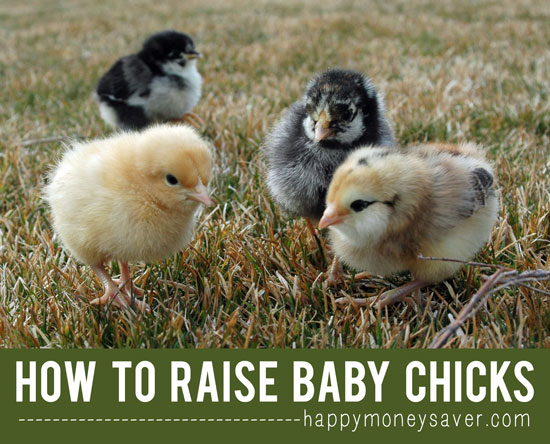
How To Raise Baby Chicks
You will need a few supplies and items to care for baby chicks. Here are the supplies you need.
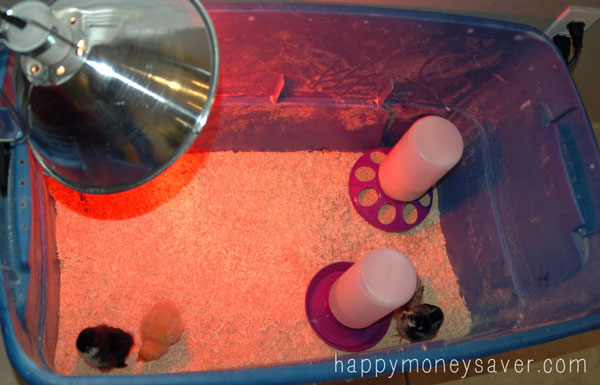 A brooder box or bin to keep them in. You can use a
stock tank, swimming pool, your bathtub or even an old kids swimming
pool. I used a plastic tote for my chicks since I already had them
hanging around my garage. Some people use a cardboard box as well, but I
don’t recommend it.
A brooder box or bin to keep them in. You can use a
stock tank, swimming pool, your bathtub or even an old kids swimming
pool. I used a plastic tote for my chicks since I already had them
hanging around my garage. Some people use a cardboard box as well, but I
don’t recommend it.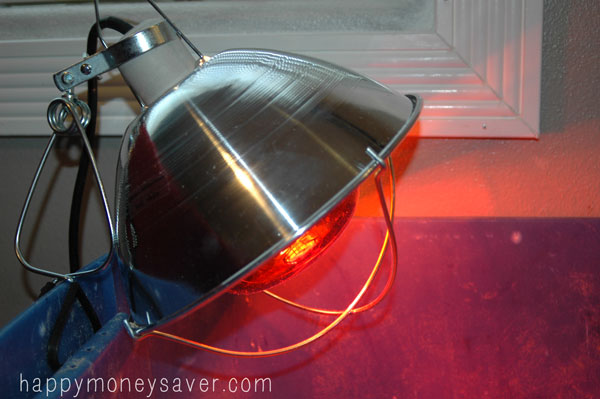 A Heat Lamp + Heat Bulb. When you buy your heat bulb
try to get the red light heat bulb. Chickens will peck each other to
death if they see blood, so the red light will make everything red thus
avoiding any pecking injuries. You could also use a white heat lamp as
well and just keep a good eye out for them. Consider also keeping a
backup heat lamp just in case one burns out.
A Heat Lamp + Heat Bulb. When you buy your heat bulb
try to get the red light heat bulb. Chickens will peck each other to
death if they see blood, so the red light will make everything red thus
avoiding any pecking injuries. You could also use a white heat lamp as
well and just keep a good eye out for them. Consider also keeping a
backup heat lamp just in case one burns out.A Thermometer – You will be using a heat lamp with a reflector, which you can find usually at the feed stores or even hardware stores. The temperature needs to be around 90 degrees for the first week, then can be reduced by 5 degrees each week until the chicks have their feathers in (usually around 6-8 weeks). Watch your chicks carefully though as they will show you if they are too hot or cold. If they are huddling in the corner farthest away from the light they are too hot, and if they are huddled in a ball under the light they are too cold. Just keep an eye on how they are reacting. Use the thermometer to get your heat lamp at the right height for the temperature needed. You can find these at your local Walmart or any hardware store for around $1.00.
Some sort of bedding. Pine shavings are what I use, but you can also use pine pellets, straw or other soft materials. Avoid cedar shavings and newspaper shreds as they are not great for chicks. Baby chicks do poop a lot so be prepared to be changing this often.
Feed – get chick starter feed from feed supply stores. This is all your chicks will need to eat. If you want to start giving them treats or bugs, wait until they are one to two weeks old first, and start some chick grit at the same time. I think the first thing I treated my chicks to when they turned a week old was a single shred of cheese, they loved it.
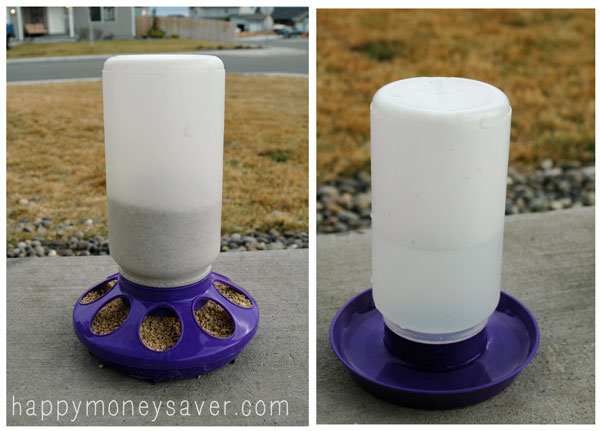 A Waterer and a Feeder - I used these little plastic
ones you can find at feed stores for a couple of bucks each. Make sure
and change out their water every day as they often poop and kick
shavings in them.
A Waterer and a Feeder - I used these little plastic
ones you can find at feed stores for a couple of bucks each. Make sure
and change out their water every day as they often poop and kick
shavings in them.Netting or chicken wire to put above your brooder box. Little chicks will fly up within a few days usually to get out, so put netting over the top to keep them from escaping. You can use a little piece of chicken wire or fine hardware mesh that covers it.
The big Chicken Coop they will be using when they are older. It’s best to get this figured out early so they are not giant chickens in a little bin while you are trying quickly & frantically to build a coop for them.
Where to get baby chicks
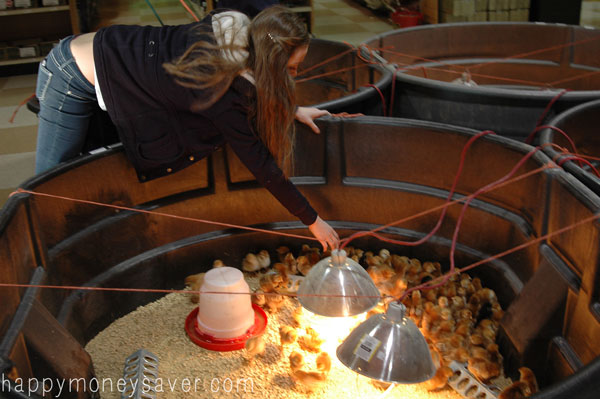 I called the feed store in my town to see when they have their “chick
days.” Turns out most feed stores have a day where they will get in a
huge lot of baby chicks where you can choose to pick up just a few or a
large lot of chicks. Some even offer free deals where if you buy the
feed you will be able to get a free chick. Make sure when you call you
ask what breeds of chicks they will be getting in.
I called the feed store in my town to see when they have their “chick
days.” Turns out most feed stores have a day where they will get in a
huge lot of baby chicks where you can choose to pick up just a few or a
large lot of chicks. Some even offer free deals where if you buy the
feed you will be able to get a free chick. Make sure when you call you
ask what breeds of chicks they will be getting in.Do some research on the kind of chickens you want to raise – whether for meat or for laying, fancy or bantam, temperaments and more.
I had my kids go online and google pictures of which breed of chicken they would like to raise. They chose by color pretty much. We went down to our local feed store on “chick day” where they each brought home the kind of chick they wanted. Going the feed store was perfect for us since we are only able to have a small amount of chicks and we were able to get a variety of chicks. It was so much fun and the kids had a blast (read about it here).
You can also order your chicks or hatching eggs online. Make sure and watch because most online chicken companies will require a minimum chicken order. If you only need a few chicks consider splitting a batch with a friend. Here are some places you can order baby chicks online:
Other hatcheries:
- Cackle Hatchery - minimum 15-20 chicks
- Freedom Ranger Hatchery – Small, family-owned hatchery supplying slow-growing broiler chickens to small farms and organic, free-range, and pastured poultry operations. They offer the Freedom Ranger chicken breed, which is a heritage breed.
- Ideal Poultry – minimum 25 chicks
- J.M. Hatchery – minimum 25 chicks
- Meyer Hatchery - low minimum order of just 3 chicks
- Murry Mcmurry Hatchery – very popular place that many people I have talked to order from.
- My Pet Chicken – you can order as few as 3 chicks with mix breeds – great for city folks like me!
- Privett Hatchery - minimum 25 chicks
- Welp Hatchery – minimum 25 chicks
Caring for your baby chicks at Home
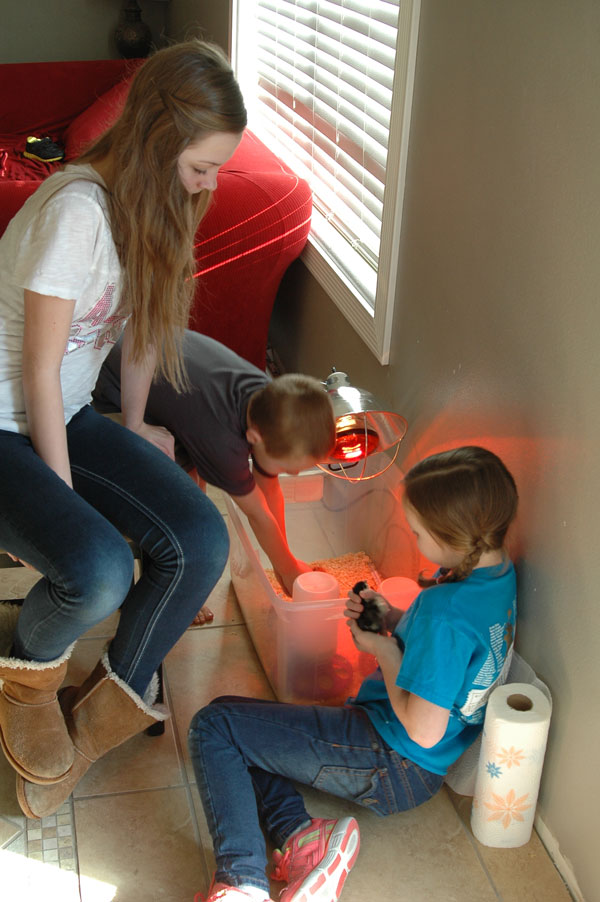 Whether you just came back from the post office or the feed store with
your new baby chicks in hand, make sure all you have their nice little
brooding box all ready to go. Make sure you have read all about how to
raise baby chicks so you are prepared.
Whether you just came back from the post office or the feed store with
your new baby chicks in hand, make sure all you have their nice little
brooding box all ready to go. Make sure you have read all about how to
raise baby chicks so you are prepared.The first thing you need to do is dip their little beaks into their waterer for a second so they knew where the water is.
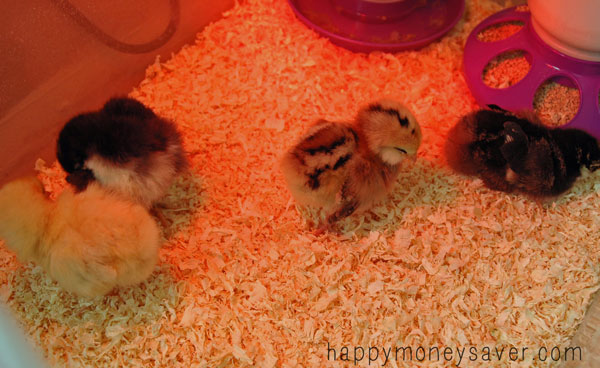 Then they will chirp around, eat their feed, poop and sleep. They will
just be running one minute and then drop like they are dead the next.
Then they will chirp around, eat their feed, poop and sleep. They will
just be running one minute and then drop like they are dead the next.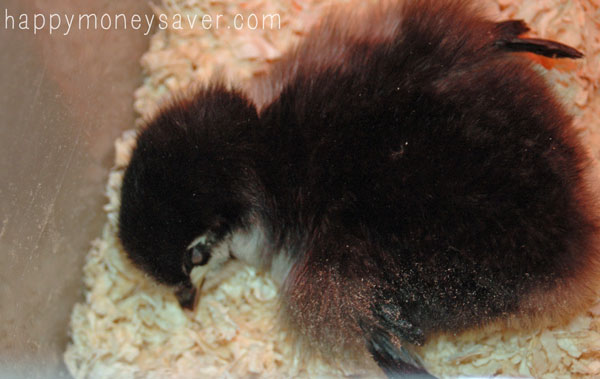 The drop-dead-look is normal, it’s just how they sleep. They are so adorable.If you find your chicks are constantly kicking their pine shavings
into your waterer, add a book covered in a ziplock bag or a weight
underneath. It helps a little. But still check the waterer often for
poop and shavings. Wash it in soap & water periodically also to keep
them healthy.
The drop-dead-look is normal, it’s just how they sleep. They are so adorable.If you find your chicks are constantly kicking their pine shavings
into your waterer, add a book covered in a ziplock bag or a weight
underneath. It helps a little. But still check the waterer often for
poop and shavings. Wash it in soap & water periodically also to keep
them healthy.
Chicken Poop & Pasty Butt
Keep an eye out for a condition called Pasty Butt with baby chicks during the first week. If the chicks get their poop stuck to their bums, it can seal it up and will kill them if they can’t go. So if you start seeing any poop stuck you gotta wash it off. Only one of our 4 chicks had this. Sorry if you are grossed out by this, but farming ain’t all flowers and fresh milk.
Oh yeah, I am making you look at a chicken’s butt. Tee hee..
 So when your chick gets Pasty Butt you just need to take a warm wash
cloth and wash the poop off gently. No picking it off, it can hurt them.
We had our baby chick sit in some warm water (in a bowl) and gently
washed it off.
So when your chick gets Pasty Butt you just need to take a warm wash
cloth and wash the poop off gently. No picking it off, it can hurt them.
We had our baby chick sit in some warm water (in a bowl) and gently
washed it off. Problem is when they have wet feathers, the others will peck at them
so you will want to separate them until dry. My son held our chick with a
wash cloth until she was dry. He loves doing things like that.
Problem is when they have wet feathers, the others will peck at them
so you will want to separate them until dry. My son held our chick with a
wash cloth until she was dry. He loves doing things like that.How often do you change their pine shavings? It all depends on your preference. I had my chicks in the house and once I could smell it I would be changing it. This was usually every 3-4 days. During the first two weeks it seemed like their poop was out of control, but as they got older their poop changed to a different consistency and I was able to change it once a week.
THE COST
I spent around $50-$60 for all the supplies I needed for my baby chicks including feed and bedding for 2 months. But the real expense can come with the big chicken coop you need to buy or build. If you are super thrifty you can use scrap wood, pallets or other materials and create for a really low cost. .Starting up chickens : cost me around $60 for all these items:
- Large plastic tote (free in my garage) you can also use a cardboard box!
- Pine shavings ($10)
- Heat Lamp with red light ($20)
- Waterer ($5)
- Feeder ($5)
- Thermometer ($1.00)
- Feed ($18 for a 50 lb bag – should last a few months)
- 4 baby chickens ($12)
Original Post By: http://happymoneysaver.com/how-to-raise-baby-chicks/
FYI
Hens will begin to lay at about 20 weeks of age. It does vary some from breed to breed. You also need to be sure that your hens are getting enough light. Poultry needs 14 hours or more of light per day to lay efficiently. This means you may continue to apply artificial light during the winter months.
..
How do you adjust the temperature with that light set up?
ReplyDelete